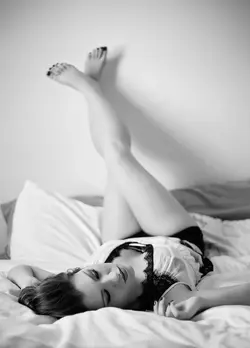Well...you mentioned using FEC to control the flash. THat makes me think you're using a Canon. Not to try and bash Canon, but the majority of Canon cameras are color-blind in their light- and flash-metering, and on many cameras, not just Canon cameras, flash exposure compensation can be tied very strongly to the exact autofocusing spot that is active and in use when the shot is made. One of the biggest 'issues' Canon has had for a long time is...erratic flash exposure...that's not just "my" opinion...it's been experienced by a lot of people. The same issue tends to occur with the Nikon D80, and to an extent, something similar with the Nikon D7000; With the D80, the exposure system was ACUTELY tuned to the AF focus bracket that was active...it was a big issue. The D7000 has a somewhat similar issue; it tends to sort of "over-process" or "over-dewvelop" its images many times, which can lead to exposures that are a bit too contrasty for many users.
I dunno...flash control in AUTO-modes can be affected by a LOT of factors!!!! One of the basics is this: bounced, or straight ahead flash???? MANY cameras do not perform all that consistently when the flash is bounced...but are exceedingly reliable on straight-ahead, in-the-shoe flash control. When you are using bounce flash, the dynamics of the flash and the room can have a positively HUGE impact...sometimes a bounced flash goes wayyyyyyy up, to say, the second story stairwell...and the amount of light that comes back down is--simply NOT strong enough for a good, generous exposure!!! Sometimes, at smaller f/stops, like f/8 or f/11, at lower ISO values, like 100 to 200, a speedlight just does not have adequate power to give enough light, especially on bounce flash set-ups.
Another little tip: when bouncing the flash, if the flash is left in AUTO-zoom mode, the flash can often be setting itself to a wide-angle focal length,like say 35mm flash coverage...that will spread the beam out very far, and so the beam is wide--and WEAK!!!! Then, when that widely-spread, weak beam bounces, what comes back is...exceedingly weak light. This is one reaosn that many mfrs. suggest that bounce flash be shot with the flash zoom control set to MANUAL, and set to a tele-setting,like 85mm or longer.
Suffice it to say--if you had problems with consistent exposure and bounced flash, there are about six things that "could have" been going wrong...not kidding...See, the thing is, the user can accidentally set a parameter, or two, that will mean the bounce flash is functioning right on the borderline between enough light, and NOT enough light. If the flash-to-wall-to-subject distance is too long for the ISO, the flash zoom, or the f/stop in use, the flash might very well NOT HAVE ENOUGH "oomph!" to make the right exposure. And that is if just one of those three (out of six) factors are wrong or marginal...



 The executions are horrible I know I chopped many limbs I was so frazzled over how it was going I started really loosing my comp. #1,2 & 4 are done with window light I gave up on the flash. #3 is the only one I even would attempt to Post process with the flash and I still strongly dislike it.
The executions are horrible I know I chopped many limbs I was so frazzled over how it was going I started really loosing my comp. #1,2 & 4 are done with window light I gave up on the flash. #3 is the only one I even would attempt to Post process with the flash and I still strongly dislike it.


 The executions are horrible I know I chopped many limbs I was so frazzled over how it was going I started really loosing my comp. #1,2 & 4 are done with window light I gave up on the flash. #3 is the only one I even would attempt to Post process with the flash and I still strongly dislike it.
The executions are horrible I know I chopped many limbs I was so frazzled over how it was going I started really loosing my comp. #1,2 & 4 are done with window light I gave up on the flash. #3 is the only one I even would attempt to Post process with the flash and I still strongly dislike it.





![[No title]](/data/xfmg/thumbnail/34/34692-a218056da5698d6c9b7cf734f656562d.jpg?1734165698)
![[No title]](/data/xfmg/thumbnail/34/34696-6e05b4fd94e150fc3d00ade3eb069dd6.jpg?1734165703)
![[No title]](/data/xfmg/thumbnail/34/34693-68d7ff80dc154cec1604c718d5434ecd.jpg?1734165700)
![[No title]](/data/xfmg/thumbnail/32/32639-1358bee897449f9a4a38676097b475d5.jpg?1734162125)





